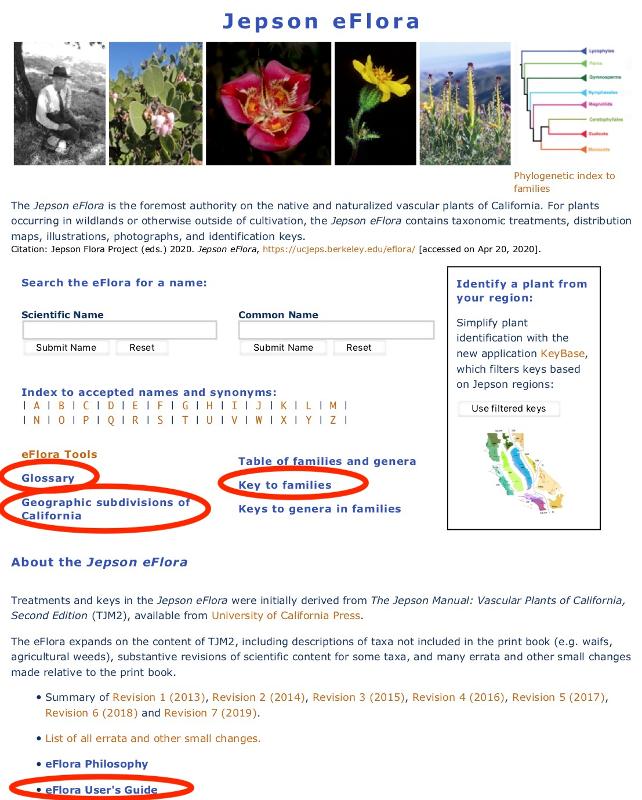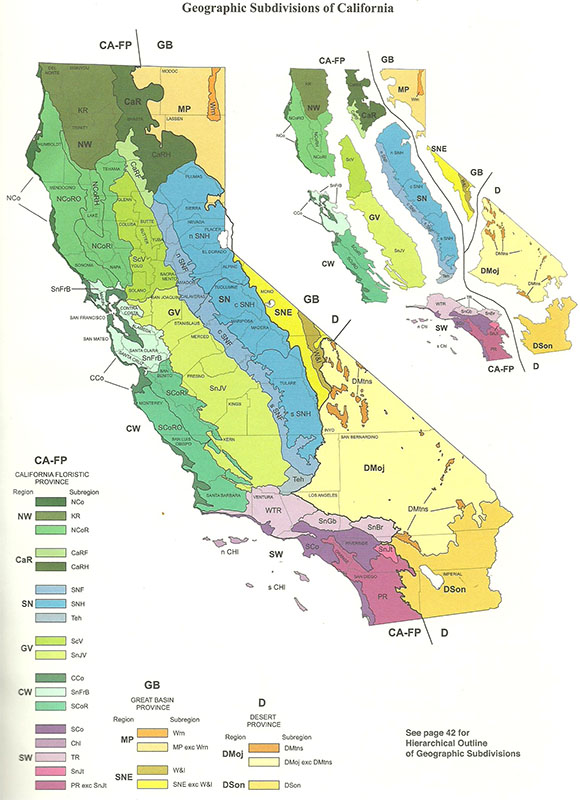Resources on the Jepson eFlora main page
Before we begin keying a plant, familiarize yourself with the resources on the main page of the Jepson eFlora (https://ucjeps.berkeley.edu/eflora/). A screenshot highlighting important links is shown below

The Key to families is where you will normally start in trying to identify a plant. (Once you learn to recognize some families, you can skip this step and go straight to the key to genera within a family.)
A Glossary is available, defining words you may not know.
The Geographic subdivisions of California is useful both for identifying plants and confirming identifications. Some places in the key will ask you choose between "ChI" (Channel Islands) and "mainland". (There are many species that are endemic to the Channel Islands.) Species descriptions also give the known range of the species. Although ranges may be shifting, the stated ranges can help confirm or reject a possible identification. For example, if you identify a plant from the San Bernardino Mountains as a species that is said to occur only on the Modoc Plateau, you should probably doubt your identification. The map from the print version of the Jepson Manual (Baldwin et al. 2012) is reproduced here:

Note that there are three major subdivisions of California: The California Floristic Province (from the major mountain ranges to the coast), the Great Basin Province (the transmontane or eastern/desert side of the mountains in the northern part of California), and the Desert Province (the transmontane region in the southern part of California). Each of these are subdivided into smaller and smaller regions.
CSUSB is at the base of the San Bernardino Mountains (abbreviated SnBr in the species descriptions), which is part of the transverse ranges (abbreviated TR, colored light pink above), which is part of the Southwestern California Region (abbreviated SW and colored pinks to purples above), which is part of California Floristic Province (Ca-FP).
Finally, there is a link to an "eFlora User's Guide" on the main page of the Jepson eFlora. If something is confusing in a key or description, read this. For now, the main thing to learn is the importance of punctuation in the key statements and descriptions:
- "Statements within a field comprise a noun (plant part) followed by its modifiers..." [excerpt from User's Guide]
- Nouns and their modifiers are separated by semicolons.
Example 1: In the statement, "Fruit 3--4 mm, ovoid; segments 10--14, margins winged, tips bristly (or segments 8--9, margins rounded, tips glabrous)," ... "tips" refers to tips of "segments," not to tips of "margins" or tips of "Fruit". Winged margins and bristly tips both describe the segments (the first word - a noun - after the semicolon).
Example 2: "in statements such as "bristles with barbs," any text that might follow does not describe "barbs," unless "barbs" is repeated)." The text would describe the bristles, until you come to another semicolon.
Check your understanding: